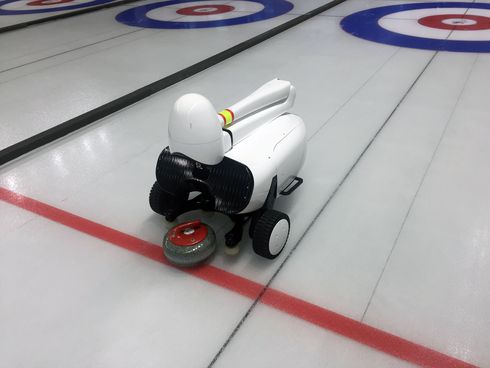AI Hits The Ice

© Korea University
Scientists from seven different Korean research institutions including Prof. Klaus-Robert Müller, head of the machine-learning group at TU Berlin and guest professor at Korea University, have developed an AI-based curling robot.
“Curly” masters the extremely complex sport on a level that is at least similar to a highly skilled amateur. On March 8, 2018, Korea University will demonstrate the robot’s skills to the public at Icheon Training Center of the Korea Paralympic Committee. As one of the highlights, “Curly” will compete with a human team from Chuncheon Machinery Industry High School following the rules of Olympic curling.
AI-based systems have demonstrated a surprising versatility not only for standard tasks of automation, but also for complex decision-making. AI has already entered many spheres of our daily lives, for instance when using search, recommendation or translation tools or online services.
Prominent AI-applications include strategic games, such as Go, Poker or Atari; but these mainly take place in virtual worlds and have access to arbitrary large amounts of data. Beyond the virtual world, how to optimally have an AI-based system interact with the real world and it’s uncertainties still poses a major challenge. First successful steps have been taken for example in robotics (see “RoboCup”) or self-driving vehicles. However, optimal interaction with the strong uncertainties of the real world while incorporating complex planning and decision-making still remains a complex and essentially unsolved problem.
The AI-based curling robot “Curly” tackles all of the challenges outlined above. Curling is a highly strategic game of combinatorial complexity – in principle even surpassing the game of “Go” in this respect, as all states are continuous. Optimal reaction to the often unforeseen moves of the opponent is crucial. Moreover, curling is played on a slippery surface, a sheet of ice.
Both the robot control for throwing a stone and the physics engine simulating the stone trajectory need to be calibrated in order to effectively compensate nonlinear friction effects and uncertainties arising from the slippery icy surface. Heterogeneous ice conditions and the systematic impossibility to assess them in detail further add to the challenge of this Olympic discipline as well as the fact that all strategic decision-making, planning, estimation while synchronizing between agents and robot control need not only to be performed within real-time constraints but also under high uncertainties. Lastly, the data available to train the deep neural network-learning component and to calibrate the overall real system is limited.
The AI-based curling robot has demonstrated the ability to master the complex game of curling astonishingly well, notably on a level that is similar to a highly skilled amateur. “The innovative challenge that 'Curly' needs to master is the interaction with an environment which is defined by extreme uncertainties. Despite the slippery surface, 'Curly' is able to plan and play well using innovative deep learning and AI techniques,” says Professor Klaus-Robert Müller, TU Berlin and Korea University.
“Superb technical challenges of this interesting real-world problem needed to be overcome by our interdisciplinary team and it is exciting to see possible future developments of such complex AI-based systems interacting with the real-world, with its large uncertainties, beyond curling,” adds Professor Seong-Whan Lee from Korea University.
“Curly” was developed by seven research institutes (서울시컬링연맹, DGIST, UNIST, 영남대학교, NT로봇, 도전하는사람들, 마농탄토) and was funded by the Ministry of Science and ICT (MSIT).
Image downloads (March 8, 2018, 7:00 am CET):
http://www.tu-berlin.de/?id=193552
For further information please contact:
Prof. Dr. Klaus-Robert Müller
TU Berlin
Phone: +49-30-314-78620
E-Mail: klaus-robert.mueller@tu-berlin.de
Media Contact
More Information:
http://www.tu-berlin.deAll latest news from the category: Information Technology
Here you can find a summary of innovations in the fields of information and data processing and up-to-date developments on IT equipment and hardware.
This area covers topics such as IT services, IT architectures, IT management and telecommunications.
Newest articles

Innovative vortex beam technology
…unleashes ultra-secure, high-capacity data transmission. Scientists have developed a breakthrough optical technology that could dramatically enhance the capacity and security of data transmission (Fig. 1). By utilizing a new type…

Tiny dancers: Scientists synchronise bacterial motion
Researchers at TU Delft have discovered that E. coli bacteria can synchronise their movements, creating order in seemingly random biological systems. By trapping individual bacteria in micro-engineered circular cavities and…

Primary investigation on ram-rotor detonation engine
Detonation is a supersonic combustion wave, characterized by a shock wave driven by the energy release from closely coupled chemical reactions. It is a typical form of pressure gain combustion,…



